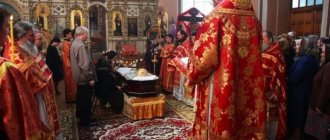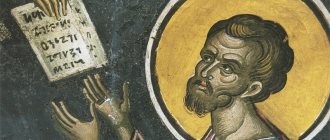Is it possible to put things in a coffin?
The Church is clearly against putting any foreign things into the coffin. However, people still ignore the advice of priests, and in a fit of emotion they can put things in the coffin that, according to signs, should never be put. It is believed that what is buried is buried. If you put your wedding ring or your personal money in the coffin of the deceased, then according to the sign, you buried them and you will no longer have much money, and you will not get married again. This applies to all personal
items you use. Any item of yours is symbolically connected with one of the areas of life: shoes - legs, a chain - chest and neck, shirt - torso. Even a shadow, according to signs, should not fall on the grave, especially at the time of burial or when the coffin lid is closed, it is believed that this is how a person calls for trouble.
Orthodox canons
According to Orthodox rites, the deceased is given a pectoral cross and a crucifix is placed in his hands. If the hands fall apart, they are tied so that the right hand is on top. A crown is placed on the forehead, and the body is covered with a funeral veil.
During the funeral service, the priest will place an icon on the chest of the deceased, which remains in the coffin. A “permissive prayer” printed on a separate sheet must be read over the deceased. After reading, it is folded and placed in the right hand of the deceased. This is done in order to resolve people’s sins, which they repented of during their lifetime before their confessor.
Before closing the coffin with a lid, the ropes are untied and left inside, the body is covered with a blanket. The priest sprinkles the deceased with consecrated earth in a cross shape. The coffin is closed with a lid and hammered for burial.
The Orthodox religion does not allow putting extraneous things if they were not indicated in the will of the deceased.
Is it possible to put a photograph in a coffin?
You should be especially careful with your photographs. In a fit of feeling, the mother or other half may come up with the idea of putting a photograph of themselves in the coffin so that the deceased would not be lonely. However, in black magic there is a ritual in which a photograph of the victim is placed in the coffin, although in this case the performer performs a special ritual. Thus, damage to health occurs, the person begins to waste away. Esotericists believe that a person with strong energy who does not believe in corruption will not be affected by simply finding his photograph in a grave. However, in any case, putting photographs in a coffin is not considered a good idea.
What can you put in a coffin?
In addition to church paraphernalia, personal belongings of the deceased are sometimes placed in the coffin. Exactly those things that only he used. For example, a wristwatch, a wedding ring, sometimes even a mobile phone. Despite the fact that the church is against putting foreign things in the coffin, people continue to do it. Firstly, if the deceased himself asked before his death to put his personal item in his coffin, his last wish must be fulfilled! So that it doesn't turn out like below.
Some people dream about the deceased after a funeral and ask them to bring him what he asked for. Some explain this by saying that in another world, without physics, the deceased misses his physical body, his things, and wants to touch them. However, of course, he doesn’t really need them. The Church believes that if such a dream occurs, then it is better to go to church and pray for the repose of the soul.
What do they put in a man's coffin?
What do they put in a woman's coffin?
The head is usually covered with a scarf. If a girl died unmarried, then she can be buried in a wedding dress with a veil, and a wreath placed at the head of the funeral. Pregnant women are sometimes given children's toys.
Magic rituals with the dead
Despite the fact that the time of witches and warlocks is far behind, some still practice black rituals. And funerals are still a favorite event for them. They will certainly take the opportunity to perform a magical ritual or obtain the necessary details for it.
During the farewell and burial rites, these people can do the following:
- lie down on the place where the person died;
- ask for the sheet on which the deceased lay;
- steal ties from the hands and feet of the deceased;
- prick the lips of the deceased with needles and then quietly take them away;
- replace personal belongings of the deceased;
- pour grain from the candlestick;
- take away the water or soap used to wash the deceased;
- go behind the coffin backwards;
- standing near the coffin with the deceased, tie knots on rags;
- take earth from the grave and put it in your bosom;
- sprinkle salt on someone present;
- putting other people's things in the coffin;
- bury things or objects in the grave;
- pick up a glass of vodka from the deceased or water from the windowsill, etc.
All these actions are aimed at connecting living people with the dead and dooming them to illness and death. Therefore, you need to be attentive to strangers at funerals, not allow strangers near the coffin, and completely stop suspicious manipulations and theft.
You also need to know that if buried objects were discovered during the care of the grave, they must be burned. At the same time, it is prohibited to touch them with bare hands!
How to behave at a funeral
Today funerals are managed by funeral directors. They know exactly all the rules of the ceremony and always promptly tell those present how to behave and what needs to be done.
As for the rest: signs and magical rituals, it all depends on you. You make a decision: to follow the advice or not, to avoid suspicious people at the funeral or not to pay attention to anyone. But in any case, during the funeral it is necessary to behave with restraint and caution, and to experience only positive feelings towards the deceased.
Let such events pass you by and do not give rise to fears and doubts. Be healthy!
What do they put in the coffin of the deceased? In fact, this is a very important issue that requires thorough, detailed comments, since today the close attention of the church is directed to it. According to statements by church representatives, most people, consciously or unwillingly, try to put various objects and things in the coffin that not only disturb the peace of living people, but also prevent the soul of a deceased person from finding peace.
According to Christian traditions, the deceased retains his lifetime passions and needs. Because of this, various objects and products are placed in the coffin: clothes, linen, bread, salt, wine, sugar. They can also put a bottle of vodka, pies, water and butter.
Do they put flowers in the coffin?
Yes, it is customary to lay flowers on the shroud at the feet of the deceased. Most often, flowers are laid in the church during the funeral service. According to another superstition, roses are not placed in a coffin, since their thorns will prick in the next world. But the main thing is that there is an even number of flowers and they are not bright in color, but emphasize the severity and sorrow of this event.
But is it possible to put fresh flowers in the coffin, or only artificial ones?
It is believed that fresh flowers produce special substances - bactericides that fight pathogens, of which there are a lot in the body of the deceased. Because of this reaction, the body of the deceased begins to turn blue. It is not for nothing that flowers are laid at the feet of the deceased, and not near the face. Previously, when the deceased was at home for a long time, this was really noticeable, but in our conditions, when flowers are laid immediately before the burial, there is no difference between fresh or artificial flowers. Moreover, some people believe that putting plastic in a grave is unethical. Wreaths are usually laid on the grave, after burial, but sometimes those closest and dearest place a wreath in the coffin. There is another superstition here: you cannot write your names on wreaths if you are going to bury the wreath with the deceased. Instead of names, you can write: from mom, aunt, friends, relatives.
Is it possible to put a cross in a coffin?
People are usually buried with a baptismal cross (some people keep the baptismal cross at home and wear a more expensive one). There is such a superstition that you cannot wear the cross of a dead person or just a stranger, since by doing so you take away his sins. If for some reason the pectoral cross was not buried with the deceased, then it should either be blessed (kept) for at least two months in holy water, or buried in a natural water source (river, lake, sea) or melted down over high heat .
It is believed that any physical thing that often comes into contact with a person (for example, a cross or a wristwatch) in one way or another absorbs the person’s energy. It’s one thing if a person was relatively healthy in every sense, and another if he had many problems. In any case, wearing the cross of the deceased, like any other thing of a stranger, is not recommended for anyone. download dle 11.1 watch movies for free
Author of the article
Hieromonk Dometian
We cannot help but grieve when those we love leave us when they die. We will mourn our dead because a loved one has left us, but we will mourn him in a Christian way. We cry over the deceased because man is not called to die, man is called to eternal life. Death entered life through human falling away from God , therefore death as such is a tragedy. On the other hand, it is liberation. If it were necessary to live without ever dying, in the limitations of earthly life that we know, there would be an inescapable nightmare... There are a number of places in the service for the deceased, where he seems to say: don’t cry for me...
We grieve for our dead with a feeling of deprivation, but with the hope of uniting with them in eternity.
Therefore, the splendor of the funeral, the popular accompaniment of the coffin, the care for the burial that spares no expense, and the arrangement of rich monuments somewhat console the living, but do not help the dead. Vain prejudices and fabrications, such as those given below, do not help, but undoubtedly harm.
They manifest themselves most visibly in the burial rite, the secrets and many fears of which no one has been able to recognize. There are many unwritten and sometimes strange rituals, which, nevertheless, are passed down from generation to generation and are performed almost with greater zeal than church prayer rituals. In the 20th century, when the Church was in a disadvantaged position in society, these pagan superstitions became widespread. They are performed without thinking about the meaning, even by people who consider themselves atheists.
For example, there is a non-Orthodox pagan custom when an ax is placed under the coffin of the deceased, coins are thrown into the coffin, into the grave. Or, when a dead person is carried out, tables and chairs in the house are turned over . It is not necessary. All this is connected with pagan customs. Mourning for the deceased is also a non-church tradition.
Among undeveloped peoples, it was believed that if a person is buried without an arm or a leg, then in the next world he will remain crippled. This pagan superstition formed the basis of the misconception among some Christians who feared that on Judgment Day their loved one would rise from the dead without a limb and remain disabled for eternity. But if the limb separated from the body, the delusional believed, was buried along with the corpse, then the problem would be resolved, and the person would be resurrected in his full form. The severed members were carefully stored so that when the time came, they could be placed in a coffin. Even teeth that had fallen out or been pulled out were preserved, sometimes for many years, and placed in the grave with their former owners. These beliefs often caused deaths when amputation was delayed until it was too late.
The custom of hanging mirrors in the house of the deceased is also associated with a tradition of folk origin and has nothing to do with the Orthodox rite of burial of the deceased. The explanations for this custom are ridiculously naive. Mirrors are closed so that the soul of the deceased, when it sees itself, is not afraid. Another interpretation: so that the deceased does not frighten relatives. It is also believed that through the mirror the soul can go into the dark world of the “looking glass”, where the devil reigns and demons rule.
Mandatory attributes in the coffin and their symbolism
According to the church, the human body serves as a temple for the soul. The burial is carried out in accordance with the ritual preserved from Old Testament times. It consists of washing the body of the deceased, dressing him in new clothes and placing him in a coffin.
It is mandatory to wear a cross on a baptized person. The hands of the deceased are folded on the chest, the left under the right. They contain an icon and a funeral cross. It is allowed to put a handkerchief; it is needed to wipe away the tears of newly arrived relatives. A wreath is placed on the head. The body is covered with a funeral blanket or sheet.
Before lowering the coffin into the grave, the icons are removed. They are prohibited from being buried. You are allowed to take them to church or leave them at home.
The crown on the head testifies to the accomplished Christian feat during life and the Orthodox faith of the deceased. It is placed in the hope that the soul will receive an imperishable symbol from God.
When the coffin is lowered into the grave, everyone present at the funeral must throw a handful of earth. And after the procession, be sure to have a ritual dinner, where the good deeds and qualities of the deceased are remembered.
Basic Rules
The clergy constantly warn that the personal belongings of the deceased should not be placed in the coffin. This could affect the peace of his soul. Of course, not all items are prohibited by the church, so you need to know exactly what is allowed and what is not. First of all, you need to make sure that the deceased does not appear in the dreams of loved ones, so you need to light a candle for the repose in the church or pray at home if you have a home iconostasis.
An important rule: things that were dear to the deceased must be distributed to poor people. Now the practice is to bring them to the church parish, which are then distributed to rehabilitation charity centers. Also, before placing a person in a coffin, his body and belongings are sprinkled with holy water. Then you need to lay a blanket and put a small pillow. This basic comfort is necessary. The following is placed on the body of the deceased:
- Pectoral cross.
- Images of saints
- Ribbon with prayer inscriptions.
The person is covered with a white sheet or another blanket up to the waist. A funeral cross is placed in the left hand, and a funeral icon should be placed on the chest. If a man is buried, then the image of the Saviors should be placed on it; for women, the image of the Mother of God should be placed. Remember that before burial, the faces of saints must be removed. They are not buried. Then you can keep them for yourself or take them to the temple and place them on the church canons, where funeral candles are placed.
Orthodox funeral
The Orthodox Church views death as a transition from earthly life to eternal life. And to get to heaven a person must undergo special training. This preparation consists of several stages:
- Unction. Before death, the priest must perform the sacrament of unction.
- Absolution. A dying person must confess his sins to a clergyman and ask for forgiveness from God and loved ones.
- Participle. The priest must give communion to the dying person before death.
- Reading the canon. The clergyman must read a parting prayer to the dying person before death. Relatives or loved ones can also do this.
- Washing and changing clothes. After the dying person has given up the ghost, he must be washed with clean water and wiped dry so that he appears clean before God. The deceased is also dressed in elegant clothes and covered with a shroud.
- Funeral lithium. 1-1.5 hours before the coffin is taken out of the house, the clergyman sprinkles the coffin and body with holy water and conducts a funeral service with censing.
- Funeral service. Before the burial, the priest reads a series of prayers and chants. Only after completing all these stages, it is believed that the deceased will be able to find eternal life in the next world.
What do they put in the coffin of a female deceased?
After death, a person’s hands and feet are tied, and measurements are taken to order a coffin with a rope. All these items must be in the coffin. They also include combs and other paraphernalia that were used to prepare the deceased for burial. They are all carriers of dead energy. Leaving such things in the house is dangerous. You can put in the coffin of a deceased woman:
- Personal items.
- A book, but not the Bible.
- Jewelry.
- Antique items.
- Things that were of great importance to the deceased.
If the deceased woman was never married, then she should be made up and dressed in a wedding dress with a veil. Little girls are given a small toy or other baby items. The cross is also placed in the coffin. You cannot keep it for yourself, much less wear it to a living person.
On a note! Flowers in the cemetery should be a light, delicate color. Experts advise giving preference to artificial or dried bouquets. The living flower can be thrown at the feet of the walking men who are carrying the coffin.
What to put in the coffin of a deceased male?
For men, items include everything that is allowed for women, with some exceptions. Required attributes:
- cloth;
- a halo on the forehead;
- manuscripts;
- funeral cross in left hand;
- shroud or burial shroud.
Men who served in the military must be buried in overalls. The uniform must correspond to his profession. If the husband of rank was not a military man, then he should wear a suit. If a little boy dies, then he also gets a toy, just like girls. An icon with the image of the Savior must be placed at the head, which is then removed for home storage.
On a note! It is better to purchase artificial flowers in colors: black and white or yellow and blue. Bright colors and delicate notes are prohibited.
What things can be put in a coffin and what are prohibited?
Despite a number of permissions and prohibitions, there is a strong opinion of all church ministers that there is no need to put anything extra in the coffin unless necessary. A person, at birth, comes into this world empty-handed. It is believed that before the soul enters the afterlife, it undergoes complete purification, and things simply remain in the earth. Many are sure that you shouldn’t even put a cross on your body, because such a ritual is very similar to a pagan one.
Another opinion is completely opposite. According to popular belief, if the coffin is half empty, then new grief awaits the family of the deceased. You cannot put things that belong to other people. This can shorten the life of the owner of the item. Things like watches and rings should be placed nearby, but under no circumstances should they be placed on hands.
Attributes such as mobile devices and other equipment should not be located near the buried person. Personal items that a person constantly uses should not be kept for himself; give them to poor people. There is no need to write any messages and put them in the coffin; all wishes can be voiced on the tombstone. The same rule applies to photographs. The comb used to tidy the deceased's hair should be buried with him. Believers say that an evil spirit is concentrated in this object.
If a person used a cane during his lifetime, then it is appropriate to bury it with him. If the deceased liked to drink, then you can put a small bottle of his favorite drink, but if he abused alcohol, then this is absolutely forbidden. It is not prohibited to put money or small change, but you should understand that in a parallel world, money will not be useful to a loved one.
IMPORTANT! The Orthodox cross should be in the hand of the deceased only during the funeral service and farewell. Before burial he is taken away. The cross and icon that are taken from the coffin are kept at home in a closed box and are taken out only on memorial days.











